Unsure about your French table manners? Click Here to download > > How to avoid these 10 food etiquette mistakes !
- Home ›
- Destinations ›
- Southwest France ›
- St-Jean-de-Luz
The Fearless Corsairs And Legendary Basque Legacy Of Saint Jean de Luz
Published 4 August 2024 by Leyla Alyanak — Parisian by birth, Lyonnaise by adoption, historian by passion
Part resort and part fishing village, Saint Jean de Luz in France’s Basque country was once a whaling town whose fishermen regularly visited Newfoundland in the 15th century. If you love history, are fascinated by Basque culture and thrilled at the thought of pirates, you’ll love this town.
Saint-Jean-de-Luz (sometimes spelled with a hyphen or two, sometimes without) is one of those towns where history and beauty vie for first place. Once a hub for whalers and later a stronghold for corsairs, this gorgeous coastal town is stuffed with stories, from royal weddings to maritime adventures.
It sits on the coast of the Pyrenées-Atlantiques department (64), in the stunning region we know as Nouvelle Aquitaine, where the river Nivelle flows into the ocean, piercing the long stretches of unbroken coastline which have made this former fishing port into a prime tourist destination and a favorite of surfers.
What to see and do in Saint-Jean-de-Luz
- Coastal attractions of Saint-Jean-de-Luz
- Historical sites of Saint-Jean-de-Luz
- Church of Saint-Jean-Baptiste
- Maison Louis XIV
- Maison Joanoenia
- Place Louis XIV
- Delicacies of Saint-Jean-de-Luz
- Les Halles
- Sweet and sweeter
- Shopping for Basque crafts
NOTE: Pages on this site may contain affiliate links, which support this site. See full Privacy Policy here.
Behind the historical curtain
You wouldn’t normally expect a small Basque tourist town to have this much history, but, yes. Everywhere I went, I stumbled over it.
The Golden Age of corsairs
Saint-Jean de Luz's prosperity in the 15th and 16th centuries stemmed from its thriving whaling and fishing industries. However, the town's fortunes took a dramatic turn in the 17th century when whaling boats lost access to Newfoundland fisheries and the town became a hub for Basque corsairs.
These state-sanctioned privateers, unlike pirates, operated legally under the French crown, disrupting enemy shipping and bringing in considerable wealth. Time hasn't tarnished the legacy of these corsairs: they remain celebrated in local folklore, and endure in the town’s architecture and cultural identity.
BASQUE CORSAIRS − NOT YOUR EVERYDAY PIRATES
The English referred to the Bay of Biscay, especially Bayonne and Saint-Jean-de-Luz, as a "nest of vipers" due to its corsair activities, akin to the "hornet nests" of Dieppe, Dunkirk, and Saint-Malo.
Unlike pirates, who operated illegally, Basque corsairs were legal privateers, capturing enemy ships in aid of France. Their own ships cost plenty to run, as they had to be equipped, and men hired and fed. Profits were shared by shareholders, the king and the crew.
Corsairs served an important purpose: King Louis XIV of France was keen to make his presence felt on the seas, and corsairs could disrupt the enemy without France having to rely on its full naval fleet, a sort of indirect naval warfare.
Often, corsairs were former whalers, adapting their whaling vessels to their new profession.
They brought back wealth, which promoted economic growth, and the tales of their adventures became part of Basque folklore, handed down through the generations. The practice ended with the Treaty of Paris in 1856, but the legacy of notable Basque corsairs endures. Some became famous, even national heroes.
Resilience, courage, love of the sea – Basques are still proud of their corsairs today. The “Order of Basque Corsairs”, a cultural association, preserves their memory and highlights their contributions to society and the economy.
A royal wedding venue
The town’s most illustrious event was (and remains) the marriage of King Louis XIV to the Infanta Maria Theresa of Spain. This union, part of the Treaty of the Pyrenees, helped end a prolonged conflict between France and Spain and resulted in one of the most important political marriages in history.
Even today, residents are proud of the royal wedding they hosted more than four centuries ago. You’ll find plenty of reminders of the event throughout town, from the places where the King and the Infanta stayed, to the church in which they were married, to the foods they ate.
Napoleon III’s engineering feat
In the mid-19th century, Emperor Napoleon III made a decision that may well have saved the town from destruction: he commissioned three dykes to protect Saint-Jean de Luz from erosion and violent storms.
The Emperor was better known for his stays in nearby Biarritz, but he often visited Saint-Jean-de-Luz with his wife, Empress Eugénie.
His intervention not only protected the town but helped – along with the arrival of the railway – transform it into a popular seaside resort, known today for its calm bay and family-friendly beaches.
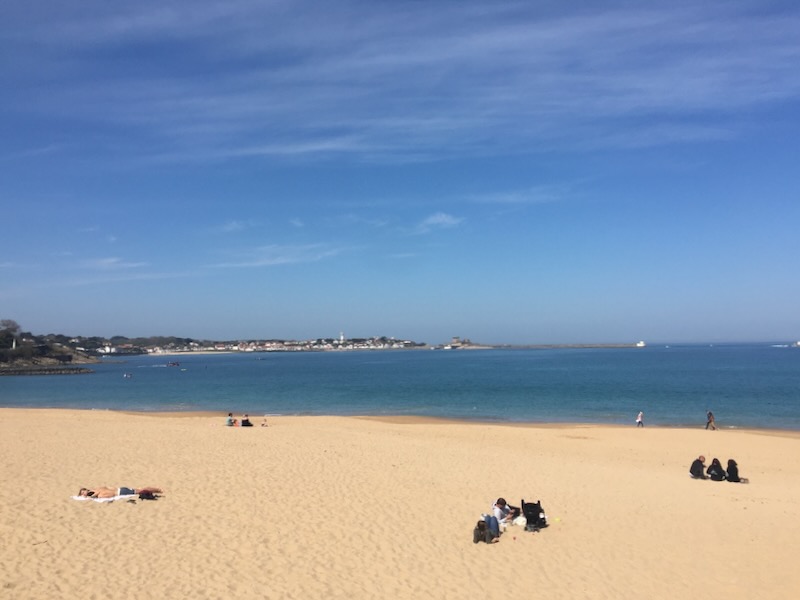 In the distance, one of the three dykes commissioned by Emperor Napoleon III ©OffbeatFrance/Anne Sterck
In the distance, one of the three dykes commissioned by Emperor Napoleon III ©OffbeatFrance/Anne SterckWorld at war
Saint-Jean-de-Luz was always a strategic port, whether in fishing or corsair days, during wars with England or Spain, or much later, in the 20th century.
During World War II, Polish soldiers gathered here in an effort to reach the Allies in Britain. Under thick cloud cover, away from prying Nazi eyes, the soldiers (along with British and French fighters) were evacuated to Britain in what is called Operation Arlel.
A total of 200,000 soldiers and civilians were able to leave for Britain through Saint-Jean-de-Luz.
The end of the war and the decline in fishing led the town to pivot towards tourism, a shift that defines its character today.
What to see and do in Saint-Jean-de-Luz
From its graceful bay to the mountains beyond and its history and architecture, this is a town in which you’ll be able to explore, learn, laze, eat or walk – there’s something for everyone here.
Coastal attractions of Saint-Jean-de-Luz
The dykes which now shelter the Grande Plage offer a scenic spot for families, safe from the powerful surfing waves so famous in this part of France.
If you've ever dreamed of surfing, this is your chance to try it out. Head for Bidart, 20 minutes away, to learn the basics.
Surfing just a little beyond your taste? Then enjoy a calmer tour of the coast by boat.
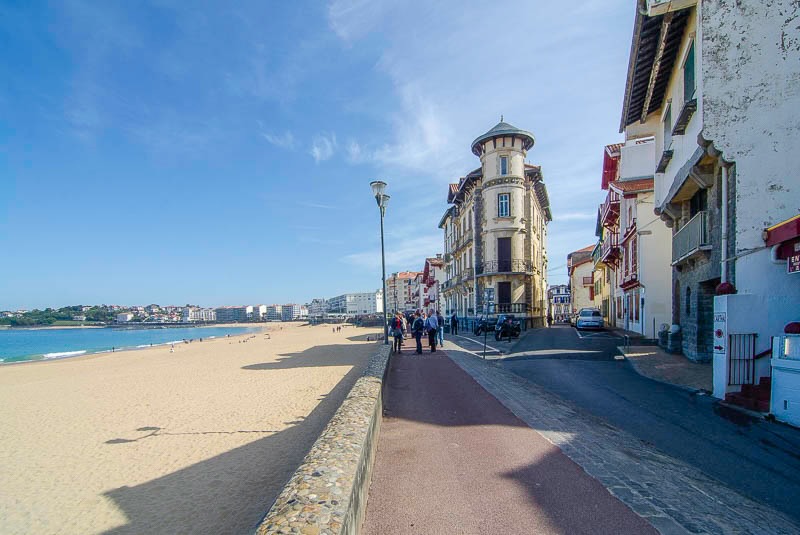
If you’re not up for the beach, head down the Promenade and enjoy the view – with the ocean on one side and plenty of Basque architecture on the other.
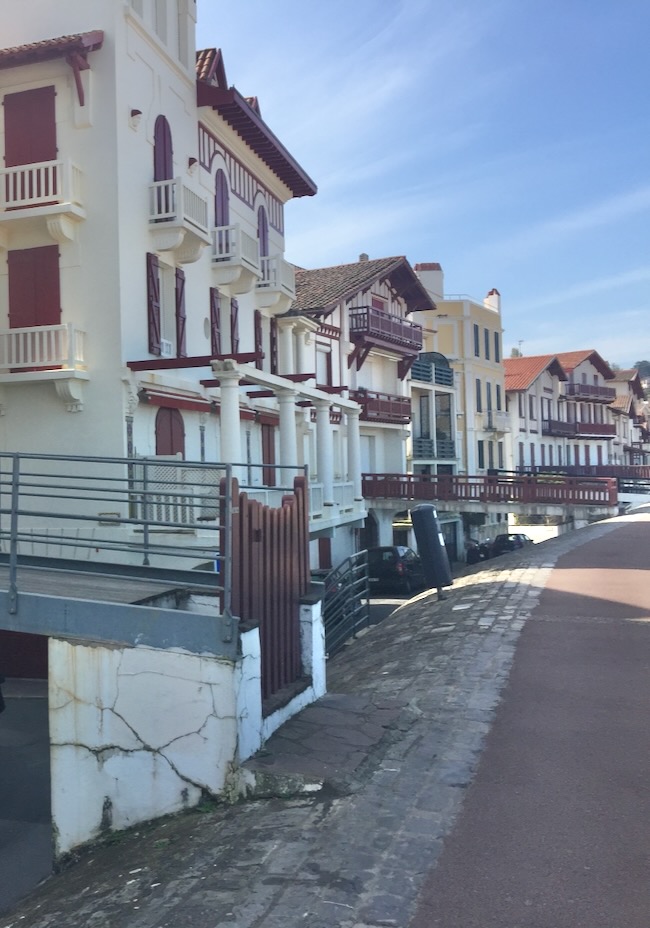 You can walk along the promenade - note the little bridges that connect the walkway to each Basque house ©OffbeatFrance
You can walk along the promenade - note the little bridges that connect the walkway to each Basque house ©OffbeatFranceWhile the Grande Plage is calm and serene, you’ll find the waves just beyond town: Lafitenia is the best known surfing beach, but you’ll also find the waves at Mayarco, Erromardie and Sainte Barbe. And there are plenty more, a short walk from the historic center.
Away from the beach, the picturesque port is exactly what you’d imagine a typical Basque fishing village to be.
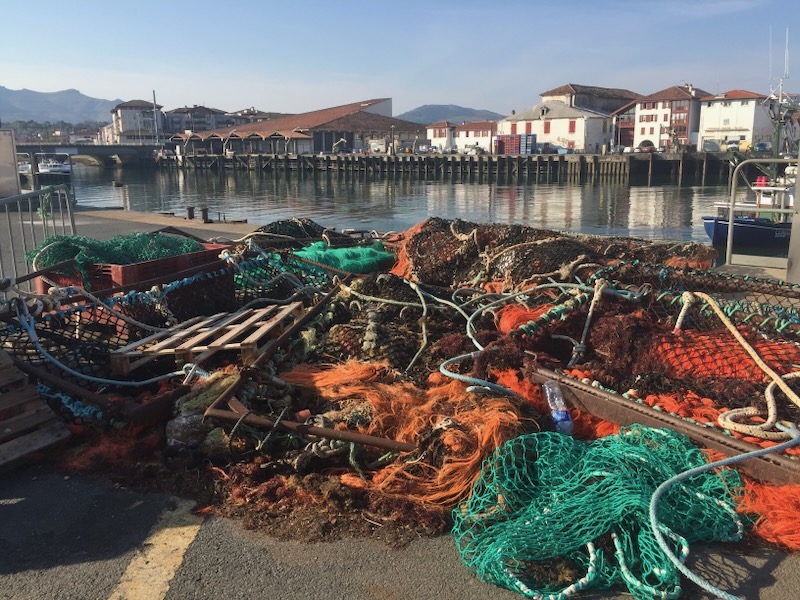 For years, Saint-Jean-de-Luz was one of France’s largest fishing ports ©OffbeatFrance
For years, Saint-Jean-de-Luz was one of France’s largest fishing ports ©OffbeatFranceA characteristic of the town are the extea, or basque houses.
You’ll recognize them immediately: they are adorned with colored half-timbering, usually dark red (symbolizing freedom), but also green (hope) and occasionally blue. The white of the houses represents faith.
Historical sites of Saint-Jean-de-Luz
Given its history, Saint-Jean-de-Luz has an abundance of sites that reflect its incredibly rich past.
Saint-Jean-Baptiste church
For me, this is the town’s main historical sight, where Louis XIV and Maria-Theresa got married on 9 June 1660.
You can’t miss it – it’s on the main pedestrian street, rue Gambetta, and you’re bound to end up here at some point.
The largest and best-known Basque church in France was built on top of a long string of churches, starting with a 12th-century Romanesque church, which was succeeded by several others, each wiped out by fire or storms.
Today’s church was built in the early 17th century and was still basically a construction site when the royal marriage took place.
It is most famous (in addition to the wedding, of course) for its interior of oak galleries, wrought iron staircases, monumental baroque altar and hanging boats.
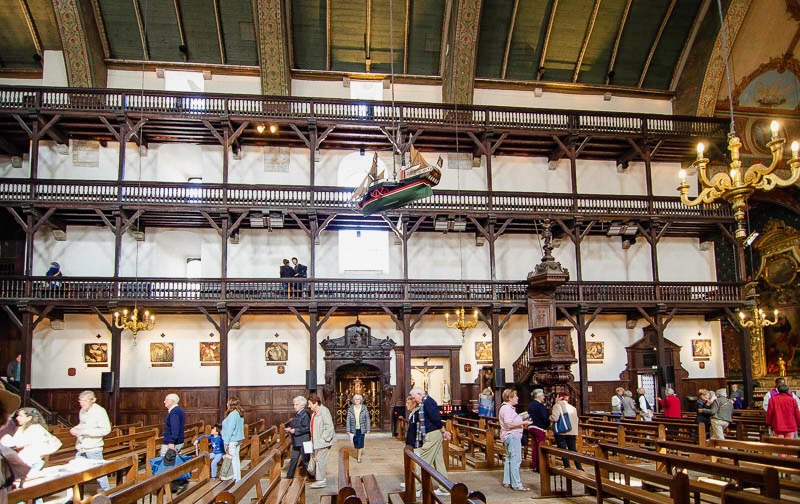
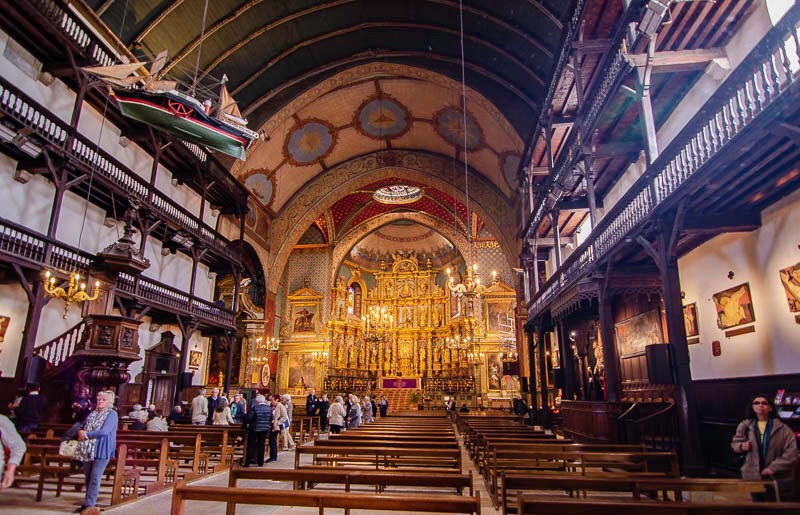 Top, inside St John the Baptist church, its galleries built to resemble a ship. Bottom, the dazzling altar, vaulted ceiling and boat ©OffbeatFrance
Top, inside St John the Baptist church, its galleries built to resemble a ship. Bottom, the dazzling altar, vaulted ceiling and boat ©OffbeatFranceA number of small-scale model boats hang from the ceiling, donated by sailors seeking blessings for a safe voyage and highlighting the town’s deep connection to the sea. One of these was a gift from the Empress Eugénie.
The church also holds a number of religious works of art: the fabulous altar, of course, but also a Louis XIV embroidery, a 15th-century stone Virgin, a painting representing the Final Judgment, and a more modern sculpture (1950) of Joan of Arc by Real del Sarte.
Maison Louis XIV
Another famous site is the Maison Louis XIV, where the King spent more than a month waiting for his fiancée's arrival from Spain. An example of 17th-century Basque wealth, the house, built in 1643, would have been nearly new when Louis arrived.
It was built by Johan de Lohobiague, a prominent shipowner who also happened to be the town’s mayor at the time, a symbol of the town’s Golden Age. Now, it is a museum.
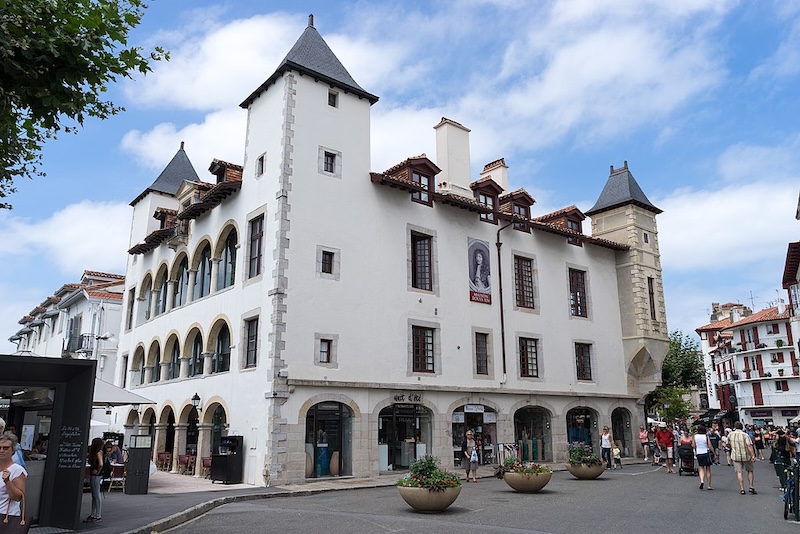 The Maison Louis XIV, an example of the elegant style of 17th-century Basque architecture. Jean-Christophe BENOIST, CC BY-SA 4.0, via Wikimedia Commons
The Maison Louis XIV, an example of the elegant style of 17th-century Basque architecture. Jean-Christophe BENOIST, CC BY-SA 4.0, via Wikimedia CommonsMaison Joanoenia
The “other” famous house is, of course, the Maison Joanoenia, or Maison de l'Infante, which housed her for several nights after she arrived for her wedding.
This elegant 17th-century building was named for one of the city’s wealthy corsairs, Joannot de Haraneder. Sadly, many similar houses were destroyed during the various fires, storms and tidal waves that damaged the city over the centuries.
You can’t miss it: it’s right on the port, all pink and golden bricks and stones and a watchtower to observe the movement of ships.
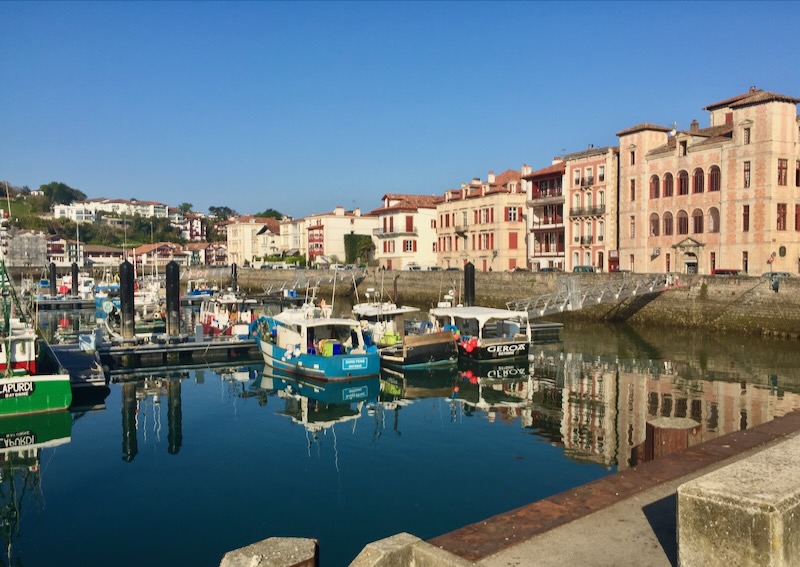 On the extreme right, the House of the Infanta, or Maison Joanoenia ©OffbeatFrance
On the extreme right, the House of the Infanta, or Maison Joanoenia ©OffbeatFranceI can’t help but think it didn’t bring the Infanta luck – her wedding wasn’t exactly an outstanding success, with her husband, Louis XIV, straying regularly. He would have many mistresses, and would remarry right after Maria-Theresa’s death in a secret ceremony to yet another mistress, Madame de Maintenon.
Place Louis XIV
Also in the center of town is the Place Louis XIV, the town’s most picturesque square, crowded in winter or summer.
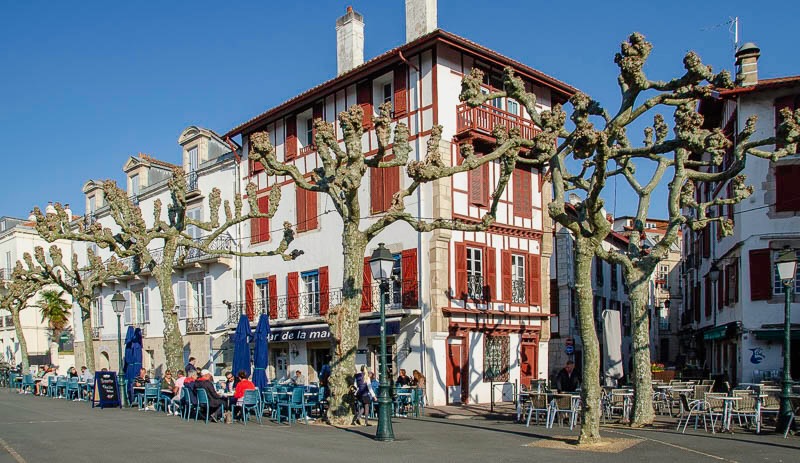 Even in winter, it remains the perfect gathering place for all seasons ©OffbeatFrance
Even in winter, it remains the perfect gathering place for all seasons ©OffbeatFranceEveryone converges here, residents and tourists, and in summer, artists and musicians. Mostly, I café-hopped, indulging in my favorite pastime, people-gazing.
Delicacies of Saint-Jean-de-Luz
All that strolling is bound to whip up an appetite, and it’s no secret that the Basque region is renowned for its food, whether on the French or the Spanish side of the border. In fact, Saint-Jean-de-Luz is home to no fewer than 16 Michelin-starred restaurants within a half-hour radius of town.
Two outstanding food-related experiences stick in my memory.
Les Halles
As is often the case in French towns, there’s a covered market, Les Halles (which means just that, “covered market”). Grab what you need for a picnic, or if you have a kitchen, prepare to regale yourself with the best fresh fish and seafood. Given the town’s fishing history, you’ll have to sample some fresh sardines and anchovies.
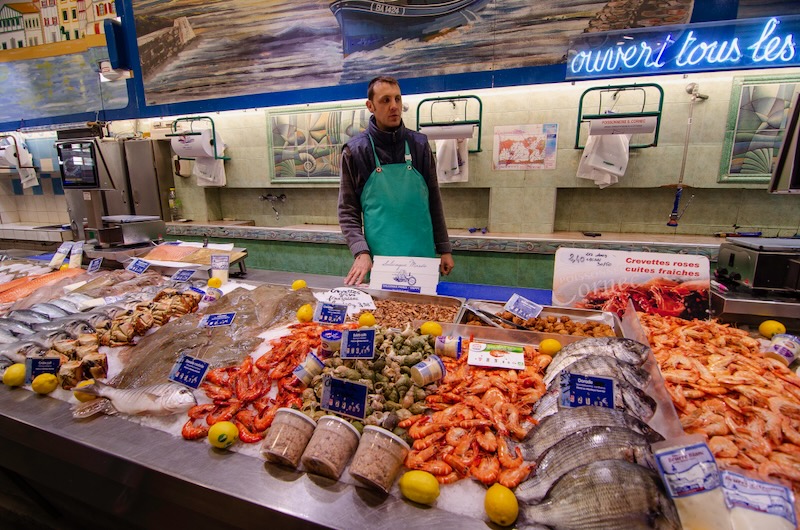
Also famous in this is region are Basque sheep’s cheeses, sold by local producers in the market, as well as pork products.
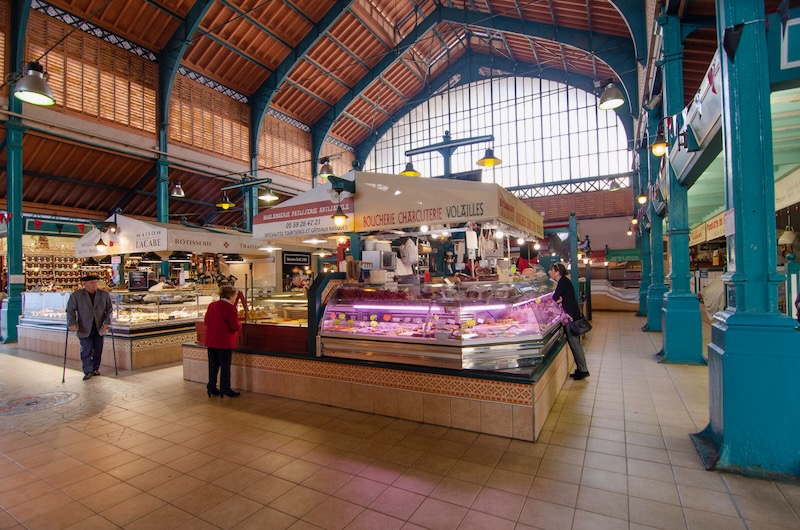
This is the place to try some charcuterie, not forgetting that the city of Bayonne, so famous for its ham, is just half an hour away.
Better yet, try the kintoa ham, made from a local pig brought back from the brink of extinction only a few decades ago. Buy some at Les Halles or at the Pierre Oteiza shop.
Sweet and sweeter
Sweets of one kind or another seem to have made this town home.
Start with some Basque macarons from Maison Adam, which are nothing like the macarons you’ll find in Paris specialty stores. They’re made with almonds, and their recipe may date back nearly 1000 years. They apparently came to fame at Louis XIV’s wedding, when Mr Adam crossed the street to offer some to Louis XIV’s mother. At least that’s the tale.
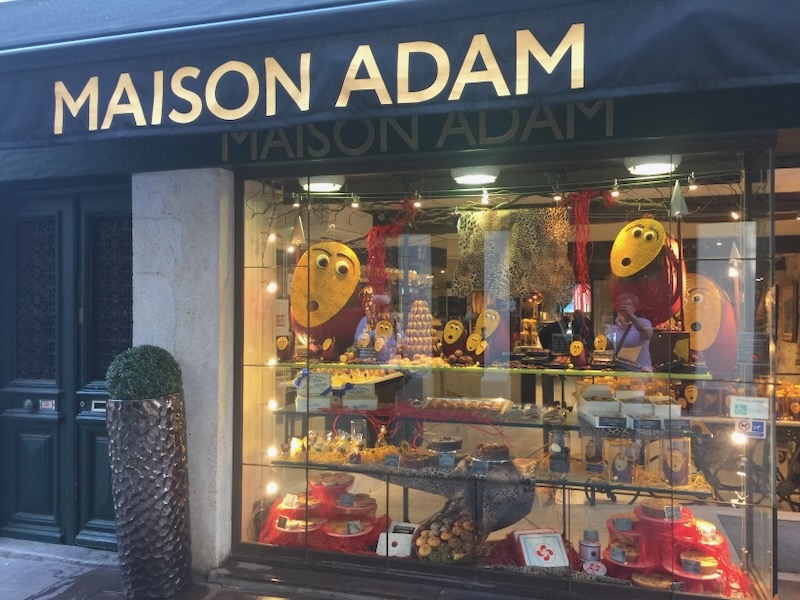 Originator of the famous local macarons, Mr. Adam began making them in the 12th century.
Originator of the famous local macarons, Mr. Adam began making them in the 12th century.And then there’s Pariès, founded in 1895, known for its chocolate and sweets.
The kanouga, invented in 1905, is a standout delight made from caramel and dark chocolate. This treat gained worldwide acclaim, at one point capturing the title of best caramel in the world. Today, 100 kg are produced daily in six flavors, including the new Kaxu with salted caramel and Espelette pepper.
Pariès also introduced the muxu, a gluten-free, lactose-free biscuit, reportedly born of a macaron mishap. Legend has it this sweet wasn’t a creation but a mistake that occurred when the pastry chef added too much almond and not enough sugar to his macaron recipe.
Rather than throw the mixture away – almonds and sugar were both very precious – he turned it into a biscuit that looked like a tender kiss. It comes in five flavors, and you should do your due diligence and try every single one.
You’ll also find the famous Gateau Basque here, first elaborated in the 16th century, made with almonds and crème patissière or black cherries.
Want someone to organize it all for you? Take a food tour – this one includes a trip to Les Halles.
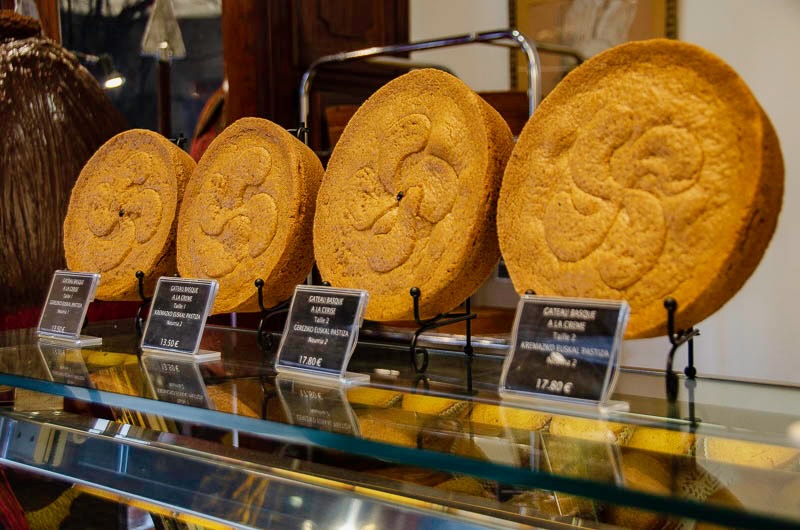 A typical selection of the famous Basque cake ©OffbeatFrance
A typical selection of the famous Basque cake ©OffbeatFranceShopping for Basque crafts
If you enjoy local artisanal goods, made by hand with techniques handed down the generations, you’ll find plenty of them here.
The well-known striped Basque fabrics can be bought everywhere in town, but a few minutes away you can also visit the Lartigue factory and see how they’re made (and learn how to avoid imitations). You can book visits here but check to see if they're in English (most are not).
This is also where you’ll find the typical woven canvas shoes, or espadrilles, which every French person uses in summer and at the beach.
On the rue Gambetta you’ll find an authentic Basque beret shop, Laulhere.
Fact: the beret originated in the region next door, the Béarn. Made of sheep’s wool, some 400 years ago it was used by shepherds as protection against the weather. Given the amount of water it takes to produce, workshops moved near the Basque gaves, or mountainous torrents, and made the beret a symbol of Basque identity. A good beret could be handed down several generations…
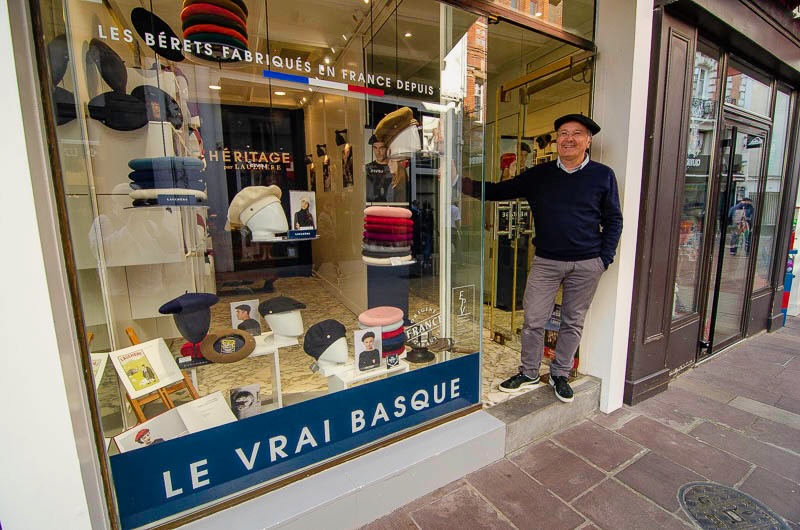
Exploring the area around Saint Jean de Luz
Easy walks around Saint-Jean-de-Luz
These aren’t exactly day trips because you don’t need an entire day, but if you’d like to get out a bit on foot, here’s what to do:
- Once you’ve visited the town center, the first thing to do is walk around the town itself. With its coastline and ancient pedestrian streets, it’s perfect for strolling.
- Walk to Ciboure, just opposite Saint-Jean-de-Luz across the bridge over the Nivelle River that separates the two towns. It’s a 15-minute walk and you’ll get a lovely view across the port. If you're there on a Sunday morning, you're in luck: there's a cheerful weekly market.
- Keep going (for about 1hr 40m) along the bay to the 17th-century Socoa Fort, which you can see in the distance. Built by Louis XIII to protect Ciboure from Spanish invaders, it was often destroyed and rebuilt. You can’t enter, but you’ll get a good idea of the varied military architecture by walking around it (not to mention great views of the bay).
- And there's always the 20min walk to the Colline Sainte-Barbe, for a fabulous view overlooking the bay of Saint-Jean-de-Luz.
Perfect day or half-day trips from Saint-Jean-de-Luz
The best-known parts of the Basque interior just happen to be close to the sea, so you won't have to go far.
Excellent roads take you uphill from Saint-Jean-de-Luz and you’ll marvel at how quickly the landscape changes from the seacoast below to the green hills and farms of the Basque country.
- Sare: A delightful village in the interior, also known for its 17th-century Church of Saint-Martin and the Basque Cake Museum. A perfect base for exploring the region (I stayed at the family-owned Hotel Arraya and loved it!) and to hop on the little train that goes up the Rhune mountain. Sare is on the official list of Most Beautiful Villages of France.
- La Rhune: The Petit Train de la Rhune departs from the Col de Saint-Ignace station in Sare. This is a cog railway that has been in operation since 1924. Along the way, you’ll get stunning views of the Pyrenees and the Atlantic Coast, and see rural “pottok” ponies found only in the Basque country. You can hike from the top, but make sure you check the weather first.
- Ainhoa: Like Sare, Ainhoa is on the “most beautiful villages” list. This is the perfect place to enjoy Basque architecture, not to mention the Basque outdoors. Many hiking trails start here, and the historic Way of St James, known as the Camino, goes through this village.
- Espelette: This village is familiar to all French, at least in name. It is the home of the famed piment d’Espelette, or red pepper, not too strong but smoky and flavored. Most things here revolve around this product: there’s an annual festival, a museum, and if the season is right, you’ll see strings of peppers drying on outdoor walls across town. You’ll find plenty of local specialties to buy as well.
- Cambo-les-Bains: Like any town ending in “les bains”, expect spas and thermal baths. And don’t miss the Belle Epoque Villa Arnaga, the former home of Edmond Rostand, author of Cyrano de Bergerac.
- Saint-Jean-Pied-de-Port: This is the jumping off point for the Camino. In contrast with its ancient cobblestoned streets, it has that particular atmosphere of new beginnings, with plenty of pilgrims setting off on their Camino across northern Spain.
- Hendaye: You’re almost in Spain by now, so don’t be surprised if a bit of that Spanish flavor creeps in. In addition to the lengthy beach, beautiful vistas and Belle Epoque villas, you’re close to the Château d'Abbadia, a neo-Gothic castle perched on a cliff.
- San Sebastian/Donostia: A perfect day trip to go “abroad”, if you’re in the mood for something different (although as part of the Basque Country but on the Spanish side, you’ll find as many similarities as differences). The city is known for its stunning beach and bay, and its world-renowned food and chefs.
- Biarritz: North of Saint-Jean-de-Luz, you have Biarritz, a mix of chic and surfer vibe. Once the playground of European royalty, you’ll still feel that air of sophistication – more 19th-century villas than you can count, and plenty of Art Deco too. Catch the views from the lighthouse or the Rocher de la Vierge, grab your picnic from Les Halles, and head down to the beach.
- Bayonne: The second-largest city in the Pyrenées-Atlantiques department, Bayonne is a traditional town with a huge cultural and culinary heritage. It is home to the famous Jambon de Bayonne (ham) and it has a reputation as the chocolate capital of France. This is also a great place to learn about Basque history, and a must-see is the gothic St Mary’s Cathedral with its mismatched towers.
The Basque Corniche and coastal path
You can explore the coast in several ways.
You can drive along the scenic coast road, which I’ve done and thoroughly enjoyed.
You can walk it along the Sentier du Littoral, although you have to be somewhat in shape because there are ups and downs.
Or you can see it all from the water by taking a boat trip along the coast.
How to get to St Jean de Luz
To get to Saint-Jean-de-Luz is simple.
- You can fly in: the Biarritz airport is a 20min drive from Saint-Jean-de-Luz, and you can take a taxi into town or hop on a bus. You could also fly to San Sebastian in Spain and take a bus straight from the airport to Saint-Jean-de-Luz.
- You can take the train: From Paris, there’s the high-speed TGV or many trains from Bordeaux.
- You can drive: Saint-Jean-de-Luz is at the tip of France, so decide whether you want to drive here or perhaps take the train and rent a car on site. To get around locally, even if you’re going to Biarritz or Bayonne, you won’t need a car – you can use local buses. Your best bet for the latest information is the local Tourist Office, which you can call or email.
- You can cycle: There are local cycle routes along uncrowded roads. You can find plenty of information on this tourist office site. The site is initially in French but if you click through to the route you want, you can then choose English to read the details.
Where to stay
For a spot of oceanside luxury in traditional basque surroundings, head for La Reserve. I've also enjoyed staying inland 20 minutes away in the beautiful village of Sare, in the magnificent family-owned Hotel Arraya.
The map below provides all accommodation options:
Before you go
Saint-Jean-de-Luz is a bit unexpected, a delightful mixture of surfing and fishing, of history, culture and natural beauty. Whatever reason draws you here, this is a town whose atmosphere and beauty you won’t forget.
If you’re thinking of spending a few days in the area, make sure you read my one-week Basque country itinerary to help with your plans!

